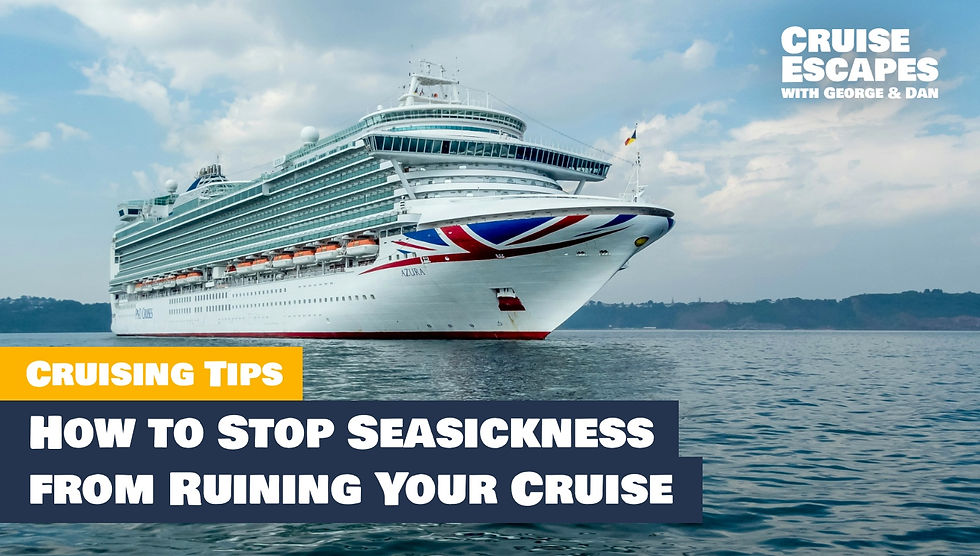How to Stop Seasickness from Ruining Your Cruise
- George and Dan

- 2 days ago
- 4 min read

Worried you might feel seasick on your cruise? You’re definitely not alone. It’s one of the biggest concerns for first-time cruisers - and even seasoned travellers sometimes get a queasy moment or two. The good news is that with the right prep (and a few clever tricks), seasickness can be avoided or at least kept well under control.
Let’s look at why it happens, how to prevent it, and what to do if you start to feel a bit off while you’re at sea.
What Actually Causes Seasickness?
Seasickness happens when your inner ear (which helps control balance) senses movement that your eyes don’t see. So, while your body feels the ship swaying, your eyes are focused on something still - like a book, phone, or wall - and your brain gets confused. That’s what causes the dizziness and nausea.
The good news? Modern cruise ships are huge and incredibly stable, fitted with advanced stabilisers that reduce movement even in choppy seas. On most voyages, you’ll hardly feel a thing.
Pick the Right Cabin Location
If you’re prone to motion sickness, the cabin you choose makes a big difference. Mid-ship and lower-deck cabins feel the least movement, as that’s the ship’s most stable point.

Avoid cabins right at the front (forward) or back (aft) if possible - they tend to feel more sway. And if you’re unsure, many cruise lines let you choose your cabin when booking, so it’s worth taking a minute to pick one that’ll help you feel comfortable.
Get Some Fresh Air and Focus on the Horizon
If you start to feel a little queasy, head outside and look out to sea. Focusing on the horizon helps your brain and body realign, making the motion easier to handle. Fresh air also works wonders, so even a short walk on deck can help.

Try to avoid sitting in enclosed spaces without windows if you’re feeling off - especially near the middle of the ship where it can feel stuffy.
Eat and Drink Smart
It might sound strange, but an empty stomach can actually make seasickness worse. Try to eat small, light meals throughout the day rather than heavy ones. Stick to plain foods like crackers, bread, fruit, or soup until you feel steady again.
Avoid too much alcohol, caffeine, or greasy foods when the sea is rough - they can make nausea worse. And drink water regularly to stay hydrated, especially if you’re taking medication.
Pack a Few Remedies (Just in Case)
It’s always worth packing a few motion sickness remedies before your cruise. Everyone’s different, so it might take a bit of trial and error to find what works best for you.
Here are a few popular options:
Sea-Bands: Reusable wristbands that use acupressure points to reduce nausea. Try these ones at Boots for £9.99.
Ginger: Tablets, chews, or tea - ginger is a natural way to calm your stomach.
Motion sickness tablets: Ask your pharmacist for advice before you travel. Brands like Stugeron or Kwells are commonly used by cruisers.
Scopolamine patches: Prescription-only, but they’re brilliant for longer cruises if you know you’re prone to motion sickness.
Start taking medication an hour or so before you sail - it’s far easier to prevent seasickness than to fix it once it starts.
Avoid Too Much Screen Time
If the ship’s moving and you’re scrolling on your phone or reading, your eyes and inner ear will be sending different signals to your brain again - the main trigger for motion sickness.

If you start to feel off, put your phone down, get up, and move around. Sometimes, just a change of scenery and a bit of fresh air is all you need.
Rest and Let Your Body Adjust
For most people, seasickness fades after the first day or two at sea as your body naturally adjusts to the motion. Rest if you need to, avoid heavy activity, and keep hydrated.
Many cruisers find that after one or two nights, they barely notice the movement at all - and by mid-cruise, they’re totally fine.
When to See the Ship’s Medical Team
If seasickness hits hard and nothing seems to help, don’t suffer in silence. Every cruise ship has a medical centre with trained staff who can help. They can give you stronger medication or an anti-nausea injection to help you recover quickly.
It’s rare that it gets to that point, but it’s good to know the support’s there if you need it.
Final Thoughts
Seasickness can sound worrying, but in reality, most cruisers never experience it - and those who do usually find it mild and short-lived. With the right preparation, you’ll be enjoying your meals, shows, and sunsets without giving it a second thought.
So don’t let seasickness stop you from booking that dream cruise. Once you’re out at sea, breathing in that ocean air, you’ll wonder why you ever worried in the first place.
Seasickness FAQ
Can I still cruise if I get motion sick easily?
Yes! Many cruisers who get car sick or air sick find they’re fine at sea. Just come prepared with medication or bands, and choose a mid-ship cabin if you can.
Do modern cruise ships really stop the movement?
Mostly, yes. Stabilisers work wonders, especially on large ships like those from P&O, MSC, or Virgin Voyages. You’ll barely notice the motion on calm seas.
What’s the best thing to eat if I feel sick?
Stick to plain foods like crackers, bananas, or bread, and avoid greasy or rich dishes until you feel better.
How long does seasickness last?
Usually just the first day or two, until your body adjusts. It’s rare for it to last the whole cruise.




Comments